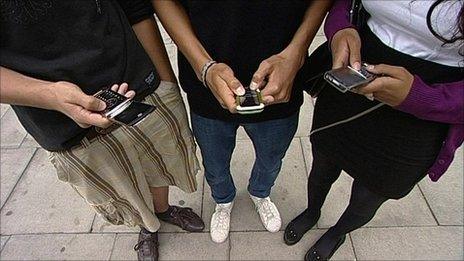Mobile phones could soon be 'powered by walking'
- Published

As we walk, we waste energy that could be harvested
Taking a stroll may soon be enough to re-charge your mobile phone, after US researchers developed a way to generate electricity from human motion.
Placed in a shoe, the device captures the energy of moving micro droplets and converts it into electrical current.
Kinetic charging is already used in some low power devices such as watches and sensors.
The University of Wisconsin team published its study in the journal Nature Communications.
"Humans, generally speaking, are very powerful energy-producing machines," said Professor Tom Krupenkin from the university's mechanical engineering department.
"While sprinting, a person can produce as much as a kilowatt of power."
That, according to the scientists, is more than enough to power a standard mobile phone.
Although similar methods exist for low power electronics, up until now there was no practical mechanical to electrical conversion technology that could provide such high levels of output, Prof Krupenkin explained.
"What's been missing is the power in the watts range," said Dr Ashley Taylor, a colleague of Prof Krupenkin.
"That's the power range needed for portable electronics."
On a larger scale, power-generating mats have been installed under the floors at two Tokyo train stations to capture the vibrations of the thousands of commuters.
The recovered energy is used to power a number of appliances, including the stations' automatic doors.
Using droplets

The device uses microscopic droplets able to conduct electrical current
The new personal mechanism uses a principle known as "reverse electrowetting" - converting the energy of moving microscopic liquid droplets into an electrical current.
Once placed in a shoe, the device - which consists of thousands of these electrically conductive droplets - is able to generate electrical energy.
There is enough power, according to the researchers, to charge a standard mobile phone or laptop.
Getting the energy from the device to the handset presents another challenge.
One way is to plug a USB cable into the shoe - probably not the most practical option.
A more sophisticated solution suggested by the University of Wisconsin team is to have the electricity-generating device connected to a shoe-bound wireless transmitter. This would take care of the power hungry part of a mobile phone's job - making radio contact with remote base stations.
Signals could be passed between the unit and the user's handset by more efficient short-range systems such as bluetooth or wifi.
The two scientists now aim to commercialise their technology at the company they have recently founded - InStep NanoPower.
Dr Patrick Joseph-Franks from the National Physical Laboratory who has also researched ways to harness energy that is otherwise wasted called the research a step in the right direction.
"When you want to charge something like a mobile phone, you want to be generating the energy locally, and the fact that you're walking around is probably the most obvious means of getting that," he said.
"Whether it's better than [carrying] some efficient solar cell on you somewhere, I don't know."
- Published28 June 2011
- Published8 July 2011
- Published22 July 2011